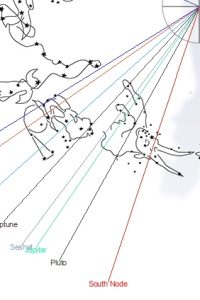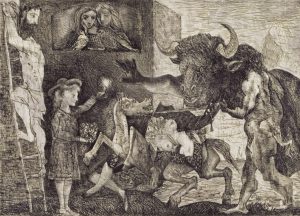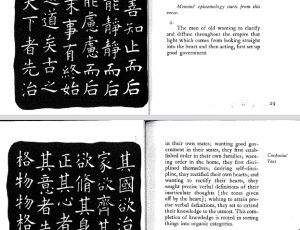The Sweet Sixteen

Above is a typical screen view of source code in HTML, Hypertext Markup Language. Only programmers can read and write code, using complex algorithms. Manifold entries in the Rimsite of celestial images encode all variations of the scripting templates (myths) and directing forces (motives) of human behavior. This format of information is itself a kind of hypertext. Fortunately, the source code in the manifold of every individual looks nothing like the above. It consists merely of 16 lines generated from a two-factor algorithm. Due to its simplicity, clarity and elegance this readout of biographic code is fondly called, “The Sweet Sixteen.”
The Prime Algorithm
The HTML image above is loaded with algorithms similar to the programming code that runs an app. What about the source code of Celestics? Is it also loaded with algorithms? No, absolutely not. In fact, there is only one algorithm in the programming code for Celestics, although it appears in 256 permutations. What does it look like and how does it work? Conveniently, how it looks and the way it works can be treated as one question. Once again, what you see in Celestics is what you get.
In the practice of forensic astronomy, you program your own code. In doing so, you engage the method at the same level of aptitude as that of the software engineer who invented it. Not at the same level of expertise, of course. Expertise comes as you learn to decode the astronomical data in the manifold and see how it is encoded in your life-narrative in the form of memes, themes, plot-lines, and scripting templates. The two-factor algorithm used for doing this is the same for everyone but it generates a different set of code-lines in each manifold. Thus it is called the prime algorithm.
Take any line in the manifold and you see the prime algorithm in a data-specific version. Venus @ 238° ↔ 28 Scorpio in the claws of the Scorpion. (Do not be mislead or confused by the occasional coincidence of signframe register and and zodiacal locale. Remember that the sign notation is only for locational purposes. This technique is fully explained in TUTORIALS and ZODIAC.) The above code line is data-specific to the individual manifold (JLL). It is an iteration of the prime algorithm. The generic form of the algorithm looks like this:
asset > engram
entry in manifold > constellation
aptitude, talent, innate gift, faculty > scripting template, narrative frame
The prime algorithm states a common sense proposition: You apply a specific asset to a course of action — “trajectory of purpose” — that you enact in a narrative frame, following a story-line framed in certain terms. In effect, you test that asset or skill within a particular narrative setting. Once you have proven that you can express that particular skill in that specific setting, you can use that asset elsewhere in any way you like, confident of self-mastery.
For instance, the generic algorithm asset > engram converts to data-specific form in the manifold of Marilyn Monroe in this way:
asset > engram
Mars @ 351° in the Western Whale
Mars :: to defy, challenge, located under the head of the Western Whale where it swims into the currents streaming from the urn of the Manitu :: Modernity, the world shaped by technology, the look of the future, the influence of the medium of cinema and the dramatic arts
Mars :: social impact in the Western Whale, the oceanic pull of mass media and the power of the visual arts, the seduction of mass spectacles, the enchantment of optics
The ZODIAC MENU presents a selection of cues and thematic memes for the complete mythography of the constellation. BIOGRAPHY illustrates how it plays out in specific case-studies of people living in the past (exemplars) and today. This inventory is always expanding. You enrich and embellish it by the investigation of your own life-narrative. This method is not speculative. It does not entail ungrounded fantasy. You test the appropriateness of the scripting templates for your own case in parallel with learning how it works in case-studies.
Here is the graphic display of some prime algorithms in the manifold of Pablo Picasso:
 Notice how this manifold is loaded in the Bull. The projections show Seshat, Jupiter, Pluto and the south lunar node all in the that engram. Select one asset from the cluster: In the location able of the manifold, you find Jupiter @ 56º in the heart of the Bull. The prime algorithm is: Jupiter > Bull. The rule of the same for everyone. You test and prove an asset in the narrative frame of the engram. How did Picasso do that with his Jupiterian asset :: to educate, to frame, to communicate a perspective of knowledge, a comprehensive viewpoint on something. It is well-known that the imagery of the Bull was one of the constants in Picasso’s art. It appears in Guernica and many drawings, often in the hybrid figure of the minotaur. The theme of the tauromachia (literally bullfight) occurs in many places, but not merely by literal reference to the Spanish spectacle of man-bull context which some find offensive. The Bull engram has many ramifications in the life-narrative of Picasso, who knew well how life imitates art — but, as well, how art can shape life.
Notice how this manifold is loaded in the Bull. The projections show Seshat, Jupiter, Pluto and the south lunar node all in the that engram. Select one asset from the cluster: In the location able of the manifold, you find Jupiter @ 56º in the heart of the Bull. The prime algorithm is: Jupiter > Bull. The rule of the same for everyone. You test and prove an asset in the narrative frame of the engram. How did Picasso do that with his Jupiterian asset :: to educate, to frame, to communicate a perspective of knowledge, a comprehensive viewpoint on something. It is well-known that the imagery of the Bull was one of the constants in Picasso’s art. It appears in Guernica and many drawings, often in the hybrid figure of the minotaur. The theme of the tauromachia (literally bullfight) occurs in many places, but not merely by literal reference to the Spanish spectacle of man-bull context which some find offensive. The Bull engram has many ramifications in the life-narrative of Picasso, who knew well how life imitates art — but, as well, how art can shape life.

Minotauromachy, c. 1930. Famous complex etching by Picasso
Whether or not one cares for Picasso’s art, it serves here to demonstrate the genomic match. Find the genomic match is the objective of practice with the manifold. It occurs when a prime algorithm such as Jupiter> art of the Bull can be identified in the known accomplishments of an individual. Prompt the algorithm with well-formed questions, and it responds with evidence. Seshat (formerly Chiron) represents the rare capacity of refute, overturn, or revise a received narrative or paradigm. Picasso totally overturned the paradigm of classical painting and drawing, like it or not. Seshat @ 54º is conjunct Jupiter, so the assets worked together.
Thematic Iteration
The diversity and richness of the mythography (literally, “the writing of myth”) in Celestics is astonishing. The thematic motifs and narratives for an engram/constellation are not limited to a single case of mythic imagery. Around the entire Rimsite, each constellation encodes more than one mythological theme, although principle or outstanding themes can be identified (in ZODIAC MENU). In practice, you free associate and select the theme that resonates most strongly for you. You don’t have to work it out by mental effort, it just springs out to you. For years of my life before I worked out Celestics, I used to identify with the Egyptian scarab. I even used it as an esoteric nickname, Khepera of Scarabeous. It occurs in line entry 10 in my manifold:
Mars @ 124° > Crab
By identification with the Scarab I already have a leading motif in my narrative. The story I tell myself about my martial skill to challenge and test uses the scripting template of the Crab. How do do I free-associate from Crab to Scarab? You will often encounter questions like this in your manifold. The mythic associations and tropes may not immediately look relevant. They are like riddles embedded in the source code. The practice is, research the mythic material and free associate on what you find. I found this:
“The name Khepera originates from African roots, particularly linked to the Yoruba culture. It embodies themes of strength and power, effectively encapsulating qualities of resilience and vitality. The name is often associated with transformative energy, symbolizing the ability to overcome obstacles and emerge stronger. In various interpretations, Khepera highlights a deep connection to heritage and identity, resonating with those who embrace its empowering essence.
Historically, Khepera is connected to ancient Egyptian mythology, where Khepera (or Khepri) was a solar deity represented by a scarab beetle. This deity was believed to symbolize rebirth and regeneration, further emphasizing the themes of strength and transformation. Over the centuries, the name has transcended its geographical origins, becoming a significant symbol of resilience in numerous African traditions. The historical usage of Khepera reflects the reverence for strength and the ongoing celebration of cultural heritage.
In contemporary times, Khepera continues to be embraced by individuals seeking a meaningful connection to their roots. The name is often used in various forms of art, literature, and music, symbolizing empowerment and cultural pride. It has gained popularity in communities that are celebrating African heritage, and it is increasingly recognized as a name that carries a powerful message. Through its modern applications, Khepera remains a strong reminder of the enduring values of strength, resilience, and cultural identity.”
I found that passage spontaneously by a ten-second search while writing this page. The precision of the way it describes my long-term commitment to advance education is astonishing. Every single point in the characterization of this motif fits me to perfection. Another theme of the Crab is the organization of things into their proper categories so that the parts reflect and harmonize with the whole. I find this theme exemplified in the Confucian standard of learning.

This is Ezra Pound’s translation of a Confucian tablet titled The Unwobbling Pivot. If I tried to describe the manner and intention of my lifelong efforts in higher education, I could not say it better. Crab :: “sorting things into organic categories.” Like the Yoruba commentary, it rings true and clear at every point. Both citations show how deep you can go in researching the “intel inside” your manifold. Intel inside is the old meme for the master chip of the CPU, the central processing unit of a computer. With forensic astronomy you access the CPU of your own psyche. Research, such as I cite here in these two cases can take you as deeply as you care to go. You can find supporting evidence like this all over the place, not only in anthropological studies and ancient documents. The clues can be found in popular culture. For instance, Spiderman (see below).
But hold on a minute. That is only one line in my manifold. It is the line specific to the Mars asset :: to challenge, test, probe. The specific form of the prime algorithm in that line indicates how I can develop and express that asset in an excellent and outstanding way. The expression of the Mars asset is not limited to that case, that narrative template, but it finds its expression there in the optimal way. The same is true for everyone and applicable to all assets. The data-specific form of the prime algorithm, aptitude > constellation, tells you where and how you can do your best at something.

Winged scarab on the pectoral of Tutankhamun. British Museum
Optical variant of the constellation of the Cab
My long-time affinity for Khepera strikes a humorous note when you consider that the scarab is a shit-beetle. Research it again:
“Ancient Egyptians thought very highly of the dung beetle, also known as the scarab (from their taxonomic family name, Scarabaeidae). They believed the dung beetle kept the Earth revolving like a giant ball of dung, linking the insect to Khepri, the Egyptian god of the rising sun.
Dung beetles have impressive “weapons”, some with a large, hornlike structure on the head or thorax that males use for fighting. They have spurs on their back legs that help them roll the dung balls, and their strong front legs are good for fighting as well as digging. Most dung beetles are strong fliers, with long flight wings folded under hardened outer wings (elytra), and can travel several miles in search of the perfect dung pat. With specialized antennae, they can catch a whiff of dung from the air.”
The dung collected is mainly used by females to lay eggs, or can eaten by adults. The weight of the dung-ball can be as much as fifty times more than the beetle. I have certainly collected a lot of dung over decades of research and study. I’ve ploughed through a lot of shit to reach “the synthesis of learning,” as I call it in Nemeta.org. I have at times been overwhelmed by the weight of the task. The dung-beetle also has a keen sense of smell. My bullshit-detector (shifting faecal metaphors here) has always been on high alert.
If you are getting the scope and diversity of Celestics, you will perhaps agree that this single code-line demonstrates Martial skill :: to defy challenge, applied to the scripting template of the Crab. It has a lot to do with how I developed Celestics out of my study in comparative mythology. Remember that the asset in any code line is an inner talent or latent skill that you test and prove in the zodiacal locale specific to it. You master it there so that you can demonstrate it anywhere. I tested and proved Mars :: social impact in the narrative frame of the Crab/Scarab :: organization of knowledge into organic categories, elegantly described in the Confucian text. So I became a comparative mythologist who applies that role to elaborating a program of higher education. The concordance of the code line with my known and proven achievement is the genomic match. Working with the manifold you seek and develop the genomic match for each asset, one line at a time.
Genomic Inheritance
The Sweet Sixteen is Celestics jargon for the 16 assets in the manifold. The totality of these entries is called the endowment. In common parlance, we say that someone is endowed with skills or qualities — to be endowed with beauty or intelligence or comedic talent, for instance. The endowment is an ensemble of capacities you inherit in a certain way. If I claim that you inherit your inner talents, you, the beneficiary, will certainly wonder who the benefactor is!
The explanation of the endowment goes to the fundamental premise of this method. It devolves on a proposition that I have researched and verified over many decades: You receive one kind of inheritance from your blood-line ancestors and another kind from humanity at large, from the entire species. The first kind is genealogical. It derives from the mix of chromosomal DNA of your parents. Blood-line inheritance requires only 5% of the total DNA in the human genome. Biologists are uncertain what to say about the remaining 95% of the human genomic identity. They resort to calling it “junk DNA.” As if it were some sort of leftover with no particular use.
Contrasted to your genealogical inheritance is your genomic inheritance. This is what comes to you from that leftover 95% of the human genome. It is the evidence of a process called phylogenetic transfer. In ORIGINS I explain this concept in relation to the theory of “the inheritance of acquired traits” proposed by Jean-Baptiste Lamarck. However, “acquired traits” is not quite the right term to describe your endowment. You do acquire certain traits by blood-line inheritance. These may be familial tendencies, similarities of appearance, and in some cases, innate abilities or interests.
What you inherit from your endowment comes from an evolutionary nexus that stands beyond chromosomal ancestry. It is species-based and, as such, transcendent to your familial biological identity. This is your genomic inheritance. In an ultimately mysterious way, it is also biological. It connects you to the entire range of human experience in the past; it makes you the beneficiary of the passions, projects, innate gifts and achievements of those who lived before you. Rather than acquired traits, which are familial, your genomic inheritance is a set of are acquired talents. Even acquired passions. These are latent aptitudes for you to discover, define, and develop. Investigation of your manifold shows you what they are and cues you on how to own and accomplish them.
The totality of your genomic inheritance is encoded in the 16 lines of your manifold. I arrived at the prime algorithm after years of research to determine if and how conventional astrology (at first) and forensic astronomy (later) aligns with various schools of modern psychology. How many did I consider? A dozen or so including the schools of Freud, Jung, Reich, Adler, Sandor Ferenczi who broke from Freud on the issue of child sexual abuse, the “fourth wave humanism” of Abraham Maslow, the child developmental psychology of Erick Erickson and Daniel Stern (The Interpersonal World of the Infant, 1985, outstanding book), object relations theory of John Bowlby, the existential psychology of Rollo May (a strong hit), the logotherapy of Victor Frankl, the transactional analysis of Eric Berg and a few more that escape me at the moment. That is a considerable burden of beetle dung.
All that research led me to the revelation that every psychological system has its provenance in the foundational theories coming forward from The Philosophy of the Unconscious (1869) by Eduard von Hartmann to Freud and Jung at the dawn of the 20th century, and then advancing to the genres of psychology cited above. That being so, it is natural to ask, Where does Celestics stand in this lineage? What is the provenance of its method? What is the background of the source code of forensic astronomy? I tracked every psychological system back to two seminal concepts, drive and primordial image. In German, treve and urbild. This “binomial equation” is the quintessence of our knowledge of the human psyche. I expect by now that you can detect it for yourself. Treve > urbild is the primary algorithm. The method of using it can be compared to prompting a LLM, a large learning machine. Interactive AI tools such as ChatGPT give results depending on two features, the training material fed into them, and the prompt used to access the material for a specific goal.
Look again at the two-factor algorithm:
treve > urbild
asset > engram
inner gift > scripting template
aptitude > test case
16 manifold entries > 16 zodiacal locales
16 X 16 = 256. That is the totality of lines in the source code of forensic astronomy. Every manifold is a unique selection of 16 lines out of the total. That is the encryption of your endowment. Compare this to the four-factor permutation of a horoscope that can generate 1000s of possible variations for the astrologer to sort out and interpret.
The Technique of Prompting
The vast repository of narratives encoded in zodiacal imagery is like a LLM. But its contents have not been trained by nerds who data mine the internet, videos, and written texts and store accumulated data in huge non eco friendly warehouses lined with hundreds of rows of interconnected consoles. None of that is alive. The zodiac is an animated celestial code bank mirrored in human neurological circuits. The method of Celestics is the forensic investigation of biographic data, the art is in the prompt. The results you get from working the manifold depend on how you prompt it. This is a simple and straightforward procedure and it is the same for everyone.
For example, look at this prompt: “How do I test my Venusian aptitude :: to enjoy by application to the scripting template of the Great Void?” This is a test case from the biography of British poet and visionary artist, William Blake, a notable exemplar. Blake has Venus > Great Void above the rear body of the Archer, a region empty of notable stars situated “in the gaze of the Goatfish.” Blake also has the lunar Perigee and Seshat (formerly Chiron) in the same locale. He tested the application of these three assets in the same locale with the same scripting template. Decode this complex against the evidence of his achievements and you will see how the mythic narratives fit those achievements. When this happens in the manifold of an exemplar or your own, you have a genomic match.
All prompting you conduct with the prime algorithm has the single and same objective: to detect a genomic match. Note the IT term application above. Each of the 16 assets runs an application, an app. But as everyone knows, if you are trying to update your OS with certain programs, some operating systems tell you, “Mac OS 10. 15.7 does not support that application.” The leading question coming into Celestics is, How does your life-narrative support the application of your innate talents to a particular script? In some instances, you may find that you have a genomic match. In that case, the specific form of the prime algorithm — Uranus > Western Whale (William Blake again) — describes something you are doing or intend to do. It matches a project you are undertaking, a passion you have entertained throughout your entire life, or a vision of how you can fulfil your purpose in life.
But what if there is no match between a line of your genomic code and your behavior? Here comes the hard lesson of Celestics. In that case, the way you are acting in life is not consistent with the optimal narrative of your life, the story that tells you the best that you can do. There is a rarely used word to describe this syndrome: prevarication. To prevaricate means to tell yourself that you are doing something, and pretend to do it, when in reality you are doing something else altogether. Prevarication is the art of living a lie and making it work.
In countless instances of human behavior, prevarication causes the failure to accomplish one’s destiny. But be advised that destiny here means the plot of your self-composed narrative, not a script imposed on you by external powers. Practice in Celestics is the perfect antidote to the insidious, all-too-human habit of prevarication. It is also an elixir for the psyche that strengthens and sharpens your ability to detect and reject self-delusion and narcissistic pretending. How much truth about yourself can you handle?
In conclusion, I could say that forensic astronomy may be the most effective tool for self-discovery ever invented. It has been that for me, but I cannot make that claim for anyone else. Only you can confirm it for yourself via this method.
©John Lamb Lash 2025. All rights reserved
